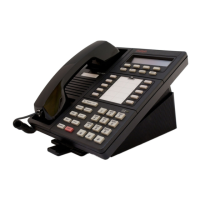MERLIN LEGEND Communications System Release 6.1
Feature Reference
555-661-110
Issue 1
August 1998
Features
Page 339Group Calling
Multi-Function
Module
A Multi-Function Module can be a member of a calling group, can be
assigned as a delay announcement for a calling group, or can be used to
connect an external alert for a Calls-in-Queue Alarm. An MFM used for
the delay announcement or Calls-in-Queue Alert should not be assigned
as a group member.
Music On Hold An outside caller who has been answered and is waiting in the calling
group queue hears Music On Hold, if programmed.
Night Service In Release 2.0 and later systems, a calling group can be a Night Service
group member.
For Release 6.1 systems and later (Hybrid/PBX mode only), a calling
group receiving Night Service calls may contain a non-local extension as
its only member.
Park A calling group member who parks a call is considered available to
receive another call.
Personal Lines If a person uses a shared personal line button to join a call in the calling
group queue, the call is removed from the queue. If a delay
announcement is playing, it is disconnected from the call.
To allow all calling group members’ telephones to ring when an outside
call is not answered within three rings, the lines/trunks programmed to
ring into the queue can also be assigned as personal lines on group
member telephones and programmed for Delay Ring. This does not work
for inside calls, remote access calls, DID calls, or when a delay
announcement device is assigned to the group.
In a Hybrid/PBX mode system where the Most Idle hunt type (Release 5.0
and later systems) is used, a calling group member may receive a calling
group call at an SA button, then put that call on hold at the SA button. If
the agent then picks up the call at a personal line button at his or her
telephone, the system no longer considers the call a calling group call.
Therefore, the agent moves to the end of the most-idle queue (Release
5.0 and later systems) and can receive another calling group call
immediately.
Pickup A calling group member can be a member of a Pickup group. Calling
group members can use Pickup to answer a call (either a calling group or
individual group member extension) that is ringing at another group
member’s telephone. Line Pickup can be used to pick up a call that is in
the calling group queue. Picking up a call on hold moves a calling group
agent to the end of the most-idle queue (Release 5.0 and later systems).
Pools Lines/trunks assigned to pools can be assigned to ring into a calling
group. An incoming call on a line/trunk assigned to the pool rings on an
SA button, even if the calling group member has a Pool button assigned
to his or her telephone.
Primary Rate Interface
and T1
A PRI line that is a member of a B-channel group programmed for routing
by dial plan should not belong to a calling group. A line that is part of a
B-channel group included in a calling group should not be programmed
for routing by dial plan.

